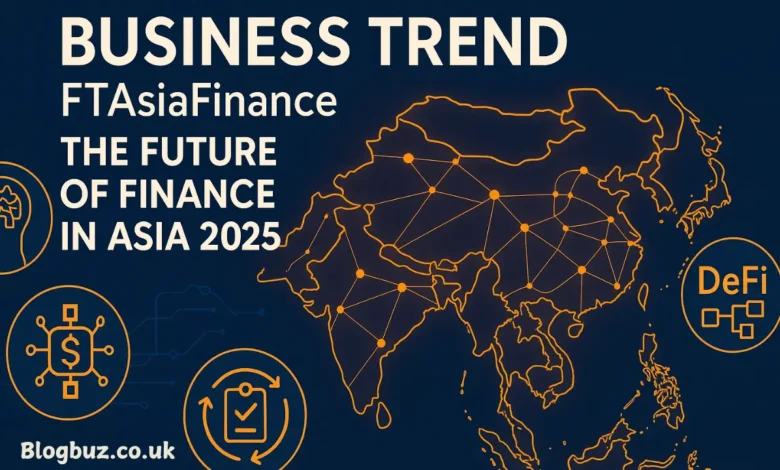Business Trend FTAsiaFinance: The Future of Finance and Business in Asia 2025

In the fast-evolving landscape of Asia’s financial markets, the business trend FTAsiaFinance has emerged as a crucial indicator of where innovation, investment, and opportunity are headed. As we navigate 2025, business leaders, investors, and tech enthusiasts closely monitor the trends highlighted by FTAsiaFinance—a respected voice in the Asian financial sector. From digital transformation and fintech innovation to ESG integration and cross-border commerce, Asia is redefining what it means to lead in the global economy. This article delves into the top business trends outlined by FTAsiaFinance, providing a comprehensive look into the forces shaping the future of Asian finance and business.
What Is FTAsiaFinance?
FTAsiaFinance refers to a network of financial thought leaders, publications, and conferences focused on tracking and interpreting economic, technological, and regulatory trends in the Asia-Pacific region. Known for deep dives into fintech, regulatory reforms, consumer behaviour, and macroeconomic analysis, FTAsiaFinance has become a go-to resource for decision-makers who want actionable insights on the Asian business frontier.
By analyzing the business trend ftasiafinance, we can extract the most current and impactful developments defining the region’s economic outlook.
AI-Powered Transformation Across Industries
Artificial Intelligence (AI) is no longer an experimental edge case but a competitive imperative. FTAsiaFinance reports that AI adoption is accelerating in Asia’s finance, healthcare, retail, logistics, and government services.
Key Points:
- Banks use AI for fraud detection, credit scoring, and personalized product recommendations.
- Retailers use AI to forecast demand, manage inventory, and deliver hyper-personalized marketing.
- Governments are deploying AI for traffic optimization, public service delivery, and national defence.
AI is not just a tool—it’s a business enabler, and companies that embrace AI-first strategies are outpacing competitors.
Rise of Decentralized Finance (DeFi) and Tokenization
Once synonymous with cryptocurrency speculation, blockchain technology has matured into a powerful business tool. According to FTAsiaFinance, 2025 marks a pivotal year in the mainstream adoption of DeFi and tokenized assets.
Business Impacts:
- Singapore, Hong Kong, and Seoul financial institutions are launching tokenized bonds and equities.
- Companies are building on-chain infrastructure to improve transparency and reduce costs.
- Due to decentralised exchanges and blockchain bridges, cross-border transactions are becoming faster and cheaper.
This shift opens investment opportunities to a broader population segment while increasing trust and accountability.
ESG Becomes a Strategic Priority
Environmental, Social, and Governance (ESG) considerations are now central to business models, not just compliance checkboxes.
FTAsiaFinance highlights that ESG integration leads to long-term profitability, lower risk, and greater access to capital. In 2025, Asian companies are embedding ESG metrics into product design, supply chain operations, and executive compensation.
Notable ESG Trends:
- ESG-linked loans and green bonds are in demand and surging.
- Startups are attracting ESG-conscious venture capital.
- Businesses that ignore ESG signals are seeing reduced market trust.
FTAsiaFinance notes that Asian consumers and investors now actively reward ESG-compliant companies, making it an urgent business imperative.
Embedded Finance and Banking-as-a-Service (BaaS)
Embedded finance is revolutionizing the way consumers interact with financial services. Imagine buying a product and receiving credit approval, insurance coverage, or investing options at checkout.
This seamless experience is powered by Banking-as-a-Service (BaaS) and API-first financial platforms.
Use Cases:
- Ride-hailing apps offering microloans.
- E-commerce stores provide instant BNPL (Buy Now, Pay Later) credit lines.
- Travel platforms bundling trip insurance and forex.
FTAsiaFinance estimates that embedded finance will become a $300 billion market in Asia-Pacific by 2030, making it one of the fastest-growing fintech segments.
Data Personalization and Identity Tech
Data is the new oil, but only if appropriately refined. Businesses now use real-time analytics, identity verification, and behavioural insights to personalize services.
Benefits:
- Reduced churn through personalized customer journeys.
- Increased conversion rates via targeted advertising.
- Fraud prevention using biometric and identity verification tools.
FTAsiaFinance notes that hyper-personalization is reshaping everything from credit scoring to app interfaces, with companies competing on experience as much as price.
Digital Wallets and Payment Innovations
In Asia, digital wallets have leapfrogged traditional banking systems. The region is home to billions of transactions through platforms like Alipay, Paytm, GCash, and GrabPay.
Trends:
- Biometric authentication for wallet access.
- Unified QR codes across countries (e.g., ASEAN integration).
- Government support for CBDCs (Central Bank Digital Currencies).
FTAsiaFinance highlights that financial inclusion and mobile-first economies drive this transformation, enabling millions to join the formal economy.
Growth in Cross-Border E-Commerce and Payments
Asia’s fragmented yet opportunity-rich market is driving cross-border trade via fintech. Platforms are now built to support:
- Multi-currency transactions
- Regional tax compliance
- Localized UX with international reach
This is especially important for D2C (Direct-to-Consumer) brands expanding from India to UAE and Singapore to Vietnam.
FTAsiaFinance suggests that interoperable payment systems and trade-friendly fintech tools will fuel Asia’s leadership in global commerce.
Fintech-as-a-Service (FaaS): The New Infrastructure Layer
Traditional companies no longer need to build payment systems or credit engines from scratch. Thanks to FaaS platforms, any company can become a fintech company by plugging into APIs.
Examples:
- A travel agency offering travel loans.
- A B2B platform integrating invoice financing.
- A gig economy app offering health insurance.
FTAsiaFinance sees FaaS as the plumbing of modern business, reducing time-to-market and enabling lean innovation.
Buy Now, Pay Later (BNPL) Goes Mainstream
BNPL isn’t new, but in 2025, it has evolved. Credit models are now risk-based, not income-based—opening doors to younger, underbanked users.
B NPL’s rise is attributed to:
- Instant credit approval via mobile
- Partnerships with merchants and digital wallets
- Sharia-compliant versions gaining traction in Muslim-majority countries
FTAsiaFinance predicts BNPL to reshape the future of consumer lending, especially in Southeast Asia.
Traditional Banks Partnering with Fintech Startups
Collaboration, not competition, is the new mantra. FTAsiaFinance reports that over 70% of leading Asian banks are forging strategic alliances with fintech firms.
These partnerships aim to:
- Combine trust with agility
- Launch neo-banks and mobile-first solutions
- Serve the SME and youth segments more efficiently
This trend shows how legacy financial institutions are adapting rather than resisting.
Summary Table: FTAsiaFinance Business Trends 2025
| Trend | Description |
|---|---|
| AI Integration | Transforming core processes across industries |
| DeFi & Tokenization | Institutional adoption of blockchain and tokenized assets |
| ESG Integration | ESG metrics embedded in strategic and operational decisions |
| Embedded Finance & BaaS | Financial services offered natively within non-financial apps |
| Personalization & Identity Tech | Real-time customization powered by data analytics and biometrics |
| Digital Wallets | Replacing bank accounts for millions across Asia |
| Cross-Border Commerce | Fintech enabling seamless trade and transactions |
| Fintech-as-a-Service (FaaS) | Plug-and-play financial features for businesses |
| Buy Now, Pay Later (BNPL) | Democratized consumer credit models |
| Bank-Fintech Partnerships | Legacy banks collaborating with agile startups |
Why This Matters for Businesses in Asia
Understanding these trends isn’t just about staying updated—it’s about staying relevant. Businesses that align with these FTAsiaFinance trends will enjoy:
- Competitive edge in customer experience
- Faster market expansion
- Investor confidence and regulatory alignment
- Future-ready digital infrastructure
Whether you’re a startup founder, enterprise executive, investor, or policy maker, these trends form the blueprint for sustainable growth in 2025 and beyond.
Final Thoughts
The business trend of the FTAsiaFinance narrative reveals an Asia that is not just adapting to global changes but leading them. With a blend of innovation, agility, and cultural adaptability, the region is writing a new playbook for digital economies.
You May Also Read: FintechZoom.com Asian Markets Today: Real-Time Insights, Trends & Market Analysis




